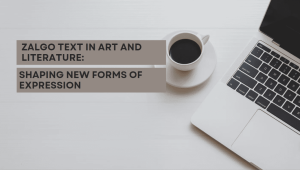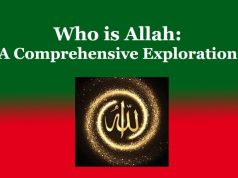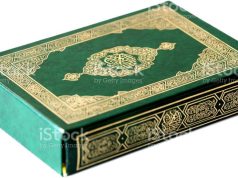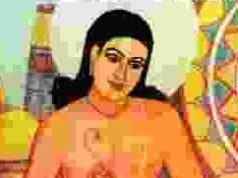Discover the impact of Zalgo text on art and literature in this insightful article. Explore how this distorted and glitchy text style is used to create new forms of expression, influence modern aesthetics, and convey themes of disruption and chaos in creative works.”
Zalgo Text in Art and Literature: Shaping New Forms of Expression
In the ever-evolving landscape of art and literature, creativity knows no bounds. From the intricate strokes of a painter’s brush to the rhythmic flow of a poet’s words, artists and authors have continually sought new ways to captivate and engage their audiences.
One such innovative phenomenon that has taken the creative world by storm is “Zalgo text,” a unique and mesmerizing form of expression that has found its place both in digital media and traditional print.
The zalgo text (Z text) can be generated by manual method or using online Zalgo Text Generator.
In this article, we delve deep into the enigmatic world of Zalgo text, exploring its origins, applications, and the ways in which it has carved out its niche in the realm of art and literature.
Unveiling the Origins of Zalgo Text
Z text, also known as “creepypasta text,” emerged from the depths of the internet subculture, shrouded in mystery and intrigue. Its name, “Zalgo,” is derived from an online meme character often depicted as a grotesque, eldritch entity.
This text style is characterized by its distorted, chaotic appearance, with letters and symbols seemingly consumed by a dark, chaotic force.
The origins of Zalgo text can be traced back to online forums and imageboards, where it was initially used to create a sense of unease and fear in stories and memes.
The Artistic Allure of Zango Text
In the world of art, Z text has found a unique niche as a form of visual expression that challenges conventional typography. Artists and graphic designers have harnessed the chaotic energy of Zalgo text to craft striking and unconventional visuals.
Its distorted and surreal appearance adds an element of intrigue and unpredictability to various art forms, making it a powerful tool for conveying emotions and concepts that defy traditional boundaries.
Zalgo in Graphic Design
Graphic designers have embraced Zalgo text to create eye-catching posters, album covers, and digital artwork. Its ability to disrupt the norm and invoke a sense of disarray has been harnessed to represent rebellion, chaos, and the unconventional in various artistic endeavors.
Zalgo in Contemporary Typography
In contemporary typography, Z text has become a symbol of breaking free from established norms. Designers experiment with it to add an element of surprise and originality to fonts, logos, and branding materials. Its usage elevates mundane text into an extraordinary visual experience.
Zalgo Text in Literature
Beyond the visual realm, Zalgo text has also made its mark in literature, pushing the boundaries of textual expression.
Writers and poets, always in pursuit of innovative ways to engage their readers, have incorporated Zalgo text into their works to create a sense of unease, suspense, and otherworldly atmospheres.
Zalgo in Poetry
In poetry, the disarray of Z text can mirror the chaos of emotions and thoughts. Poets have utilized it to convey a sense of inner turmoil, blurring the lines between the written word and raw emotions.
The fragmented and distorted appearance of Zalgo text adds layers of complexity to poetic verses.
Zalgo in Fiction
In the realm of fiction, Z text has found its place in storytelling. Authors have employed it to create tension, mystery, and a sense of impending doom in their narratives.
The juxtaposition of standard text with Zalgo-transformed passages immerses readers in an eerie and unsettling reading experience.
The Digital Age and Zalgo Text
With the advent of the digital age, Z text has found a home on the internet, where its enigmatic allure continues to captivate online communities.
Social media platforms, blogs, and websites have all witnessed the use of Zalgo text in various contexts, from memes and storytelling to online branding.
Meme Culture and Zalgo
Memes, as a form of internet culture, have embraced Zalgo text for its ability to create a sense of unease and humor simultaneously. Internet users have ingeniously incorporated Zalgo text into memes to deliver unexpected punchlines and elicit reactions from their audience.
Online Communities and Zalgo
Online communities, known for their diversity and creativity, have harnessed the power of Zalgo text to establish unique identities and communication styles. It has become a symbolic language for those who seek to challenge norms and conventions.
Conclusion
In the ever-evolving landscape of art and literature, Z text stands as a testament to human creativity and the endless quest for innovative forms of expression.
From its obscure origins in internet subculture to its prominent role in contemporary art and literature, Z text has proven that it can transcend boundaries and expectations.
Whether in the hands of graphic designers, poets, or meme creators, Z text has reshaped the way we perceive and engage with written and visual communication.
As we continue to explore new frontiers of creativity and self-expression, Z text remains a powerful tool, challenging us to embrace the chaos and redefine the limits of our imagination. 0 0 0.
Zalgo Text in Art and Literature
1. What is Z text, and how is it used in art and literature?
Z text is a form of distorted text characterized by the addition of excessive diacritical marks, unusual symbols, and erratic formatting that creates a glitchy, unsettling appearance. This style of text is often used to evoke feelings of chaos, horror, or the supernatural. In art and literature, Z text serves as a tool for enhancing the thematic elements of disorientation and disruption. For instance, in digital art, Zalgo text can be incorporated into visual compositions to create a sense of visual and textual distortion, adding layers of meaning or emotional impact. In literature, particularly in genres like horror or experimental fiction, Z text can be used to depict madness, corruption, or the intrusion of unnatural forces. Its unique aesthetic and capacity to convey a sense of distortion make it a powerful device for exploring themes that are difficult to represent through traditional text formats.
2. How did Z text originate, and what are its cultural and technological influences?
Z text originated from internet culture, particularly within online forums and meme communities. It became popular around the early 2000s as a way to create visually disturbing text effects, often used in horror-themed content or to give an unsettling tone to otherwise normal text. The name “Zalgo” comes from a fictional character associated with cosmic horror, representing an incomprehensible and malevolent force. The technology behind Zalgo text involves using Unicode characters to overlay and combine diacritical marks, resulting in a corrupted and chaotic appearance. Cultural influences include the broader fascination with glitch art, horror aesthetics, and internet subcultures that enjoy exploring themes of the uncanny and the bizarre. Z text reflects a fusion of technological manipulation and cultural expression, representing a modern evolution in how text can be used creatively to impact the viewer’s experience.
3. What are the effects of using Z text in creative works, and how does it affect the reader’s perception?
Using Z text (Z text) in creative works can have a profound impact on the reader’s perception by altering the traditional reading experience. The chaotic and distorted nature of Zalgo text can disrupt the flow of reading, creating a sense of unease or discomfort. This effect can enhance the thematic elements of a work, especially in genres that deal with horror, madness, or the supernatural. The visual disruption of Z text can evoke a visceral reaction, drawing the reader’s attention to the text as an object of art rather than just a medium of communication. By challenging conventional text presentation, Z text can also emphasize the emotional or psychological state of characters or the thematic undercurrents of the narrative. Overall, the use of Zalgo text can deepen the reader’s engagement with the material by creating a multi-sensory experience that aligns with the work’s thematic goals.
4. What are the challenges and considerations when incorporating Zalgo text into artistic and literary projects?
Incorporating Z text into artistic and literary projects presents several challenges and considerations. One challenge is ensuring that the text remains legible and does not hinder comprehension, especially if the primary goal is to communicate specific content. The excessive distortion can sometimes make it difficult for readers to decode the message, which could detract from the effectiveness of the work if not used judiciously. Another consideration is the potential for overuse; while Z text can be impactful, its novelty may wear off if used excessively or without a clear purpose. Additionally, integrating Z text into printed or physical media may require special formatting techniques to preserve its visual effect. Creators should carefully balance the use of Zalgo text with the overall design and narrative objectives to ensure it enhances rather than overwhelms the work. When done thoughtfully, Zalgo text can add a unique and memorable dimension to art and literature, but it must be employed with attention to its potential impact on the audience. 0 0 0
You May Like:
Song Lyrics Generator by Paraphrasingtool.ai:







